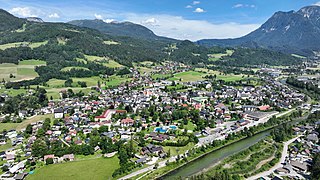
Eisenstadt is the capital city of the Austrian state of Burgenland. With a population of 15,074, it is the smallest state capital and the 38th-largest city in Austria overall. It lies at the foot of the Leitha Mountains hill range.

NicolaAntonio Giacinto Porpora was an Italian composer and teacher of singing of the Baroque era, whose most famous singing students were the castrati Farinelli and Caffarelli. Other students included composers Johann Adolph Hasse, Matteo Capranica and Joseph Haydn.

Bad Goisern am Hallstättersee is a market town in the Austrian state of Upper Austria in the district of Gmunden. It is part of the Salzkammergut resort area. At the 2005 census Bad Goisern am Hallstättersee had a population of 7,578 inhabitants.

The market town of Bad Fischau-Brunn is an Austrian municipality in the district of Wiener Neustadt-Land in Lower Austria. It is situated some 50 km south of Vienna at the edge of Viennese Basin.

Bruck an der Leitha is a town in the Austrian state of Lower Austria on the border of Burgenland, marked by the Leitha river. In 2018 it had a population of around 8,000.
Rohrau is a village in the state of Lower Austria. The name comes from two German words: Rohr (reed) and Au. South of the village is a riparian forest and a swamp covered with reed.

Hainburg an der Donau is a town located in the Bruck an der Leitha district in the state of Lower Austria of eastern Austria. In 2021 it had a population of about 7,000.

Puchberg am Schneeberg is a town in the south-eastern part of Lower Austria with approximately 2650 inhabitants. It is situated about 80 Kilometres from Vienna. The highest point of Puchberg is the Schneeberg with 2076 m, the highest mountain of Lower Austria.

Bad Tatzmannsdorf is a municipality in Burgenland in the district of Oberwart in Austria.
Bezirk Bruck an der Leitha is a district of the state of Lower Austria in Austria.

Bad Hall is a market town in the Steyr-Land district of the Austrian state of Upper Austria. Its name, Bad Hall, means "salt bath," a reference to its long history of baths and spas. It is renowned for its saline springs, strongly impregnated with iodine and bromine. Although the springs have been known since the 8th century, Hall has been noted for them only since 1855, when the springs became the property of the government.

Au am Leithaberge is a town in the district of Bruck an der Leitha in Lower Austria in Austria.

Bad Deutsch-Altenburg, until 1928 Deutsch-Altenburg is a market town and spa in the district of Bruck an der Leitha in Lower Austria in Austria.

Hof am Leithaberge is a town in the district of Bruck an der Leitha in Lower Austria in Austria.

Trautmannsdorf an der Leitha is a town in the district of Bruck an der Leitha in Lower Austria in Austria.

Angern an der March is a market town in the district of Gänserndorf in the Austrian state of Lower Austria. The municipality consists of the Katastralgemeinden Angern, Grub, Mannersdorf, Ollersdorf and Stillfried.

Gumpoldskirchen is a town in the district of Mödling in the Austrian state of Lower Austria. Gumpoldskirchen borders on the municipalities Mödling, Guntramsdorf, Gaaden, Pfaffstätten and Traiskirchen. The municipal area extends from the flats in the Vienna Basin to forest areas of the Anninger in the Vienna Woods. Gumpoldskirchen is very famous for its wine, especially its Spätrot-Rotgipfler blend, and "Heurigers" as it attracts many tourists from Vienna to its hillside vineyards. Gumpoldskirchen derives its name from Gumpold of Passau.

Guntramsdorf is a town in the district of Mödling in the Austrian state of Lower Austria. As part of the "Industrieviertel", the industrial region in the southeast of Lower Austria, it is well connected to the country capital Vienna. The local rail service Badner Bahn connects Guntramsdorf with the central district of Vienna in the north and popular spa resort destination Baden bei Wien in the south. In the west of the town lies the Vienna Woods, an outlier of the Alpine foothills, featuring recreational forest areas and hiking trails, and the southeast of Guntramsdorf extends into the thermal Vienna Basin.

The Imperial Royal Privileged Austrian State Railway Company, from 1 January 1883 the Privileged Austro-Hungarian State Railway Company was a private railway company in Austria-Hungary. Its title was abbreviated to State Railway Company (Staats-Eisenbahn-Gesellschaft) or StEG.

























